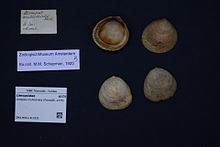Rank Family Subclass Pteriomorphia | Scientific name Limopsidae Order Arcida | |
 | ||
Similar Limopsis, Bivalvia, Noetiidae, Glycymerididae, Molluscs | ||
Limopsidae is a family of bivalves, related to the ark clams and bittersweets. This family contains about thirty species in seven genera.
Contents
Species
Limopsis
Species of the genus Limopsis are among the few suspension feeding deep-sea bivalves, and are absent from the continental shelf. They are relatively small, byssate (i.e. attached to the sea floor by strong threads, or byssus), and, while the viscera are reduced, there is a comparatively thick shell. Differences between species are usually defined by minor differences in gill and palp structure. The eggs are relatively few and of a size which suggests that the planktonic larvae do not feed.[1]
References
Limopsidae Wikipedia(Text) CC BY-SA
